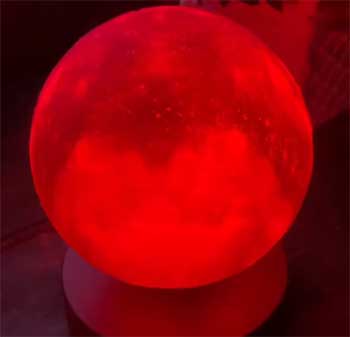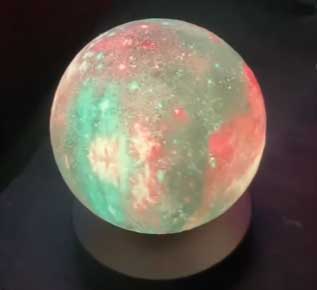Levitating moon lamps have become an increasingly popular home decor item in recent years. Often sold under brands like VGAzer, these futuristic lamps use magnetic levitation to make a small globe float and glow, creating a magical moon-like effect.
However, these lamps also come with their fair share of problems. As a new technology that pushes boundaries, levitating moon lamps can sometimes malfunction or break.
In this article, we’ll take an in-depth look at some of the most common VGAzer levitating moon lamp problems users report. We’ll explain each issue in a straightforward way, suggest troubleshooting tips, and provide insight into why these problems happen in the first place.
Our goal is to equip readers with the knowledge to resolve or prevent any levitating moon lamp problems they may encounter.
Problems With VGAzer Levitating Moon Lamp
Here is a list of those issues:
- Visual Defects
- Levitation Failure
- Overheating Issues
- Short Battery Life
- Noisy Operation
- Power Button Issues
Let’s elaborate those problems in detail.
Visual Defects
One of the most frequently reported issues with VGAzer moon lamps is visual defects in the floating globe. These defects can take various forms:

- Scratches or cracks – The acrylic globe may arrive or develop small scratches or cracks on its surface that distort the glowing light inside. These are likely caused by manufacturing flaws or damage during shipping.
- Cloudiness – Over time, the interior or exterior of the globe may develop a foggy, cloudy appearance that diminishes the clarity of the lighting effect. This can occur when moisture or dust gets trapped inside the sealed globe.
- Discoloration – Some users notice their moon lamp’s globe takes on a yellow/brown tint rather than remaining crystal clear. The source could be UV damage or chemical changes in the acrylic material.
- Bubbles – Tiny air bubbles may be visible inside the globe, marring the hypnotic ambiance. These likely originate from the liquid filling process.
The best remedy is to contact the manufacturer about a replacement globe under warranty if any of these issues emerge. For fogginess, leaving the lamp off and storing it in a warm, dry place for a couple days may help moisture evaporate.
Levitation Failure
The quintessential feature of a levitating moon lamp is the magical floating effect. So naturally, problems with levitation malfunctions are highly concerning. There are a few reasons the levitating globe may sink or stop hovering:
- Power loss – If the lamp loses consistent power, the electromagnets will stop working and levitation will fail. Check that the USB cable is plugged in fully and that the power source (outlet, computer, power brick) is functional.
- Magnet malfunction – Issues with the internal electromagnets or circuitry can lead to failed levitation. Troubleshoot by plugging the lamp into different ports or devices to see if the problem persists.
- Imbalance – The lamp must remain precisely balanced for the globe to float properly. Jostling or bumping the base can disrupt the equilibrium. Gently adjust the base position to restore balance.
- Broken base – Extreme mishandling can damage the portion of the base that houses the magnets and electronics, preventing successful levitation. Avoid aggressive shaking and transporting without packaging.
With patience and some trial-and-error, most brief levitation stoppages can be fixed by users at home. But for persistent problems, replacing defective electrical components may be required.
Overheating
Levitating moon lamps rely on internal circuitry and electromagnets to induce the floating effect. But these electronic components can generate significant heat, especially when the lamp runs for long periods. Insufficient cooling and ventilation may cause the lamp base to become hot to the touch.
There are a few ways to prevent hazardous overheating:

- Add space – Ensure at least 4 inches of clearance around the top and sides of the lamp base for proper airflow.
- Avoid enclosures – Don’t place the lamp in tightly enclosed areas like cabinets, which block airflow.
- Use a timer – Set the lamp to turn off automatically after a few hours with an outlet timer. This ensures the electronics get regular rest.
- Clean the vents – Use compressed air to remove any dust blocking the ventilation holes on the base, which can trap heat.
- Check the voltage – Operating the lamp at voltages higher than the labeled specification can overdrive the electrical components. Use only the recommended voltage.
If the base remains dangerously hot even with these precautions, a faulty internal fan may need replacement. Contact the manufacturer for options.
Short Battery Life
VGAzer’s levitating moon lamps can function as portable nightlights thanks to built-in rechargeable batteries. But some users complain that the battery seems to drain exceptionally quickly, delivering under an hour of levitating time per charge. Rapidly diminishing battery capacity is likely the result of:
- Faulty battery – Some lamps ship with defective lithium batteries prone to early failure. Replace it under warranty if the lifespan seems far below specifications.
- Overcharging – Leaving the lamp plugged in well past a full charge taxes the battery. Unplug it once fully charged.
- High temperatures – Heat degrades batteries quicker. Keep the lamp away from hot surfaces and direct sunlight.
- Frequent levitation – The electromagnetic levitation is power-hungry. Minimize floating time to conserve the battery. Use wall power for long-term enjoyment.
- Old age – Rechargeable batteries have a limited lifespan. If the lamp is several years old, its battery has naturally lost capacity. Replacement batteries can be purchased and installed.
With careful charging habits and battery maintenance, most levitating moon lamps can fulfill their promised hours of portable illumination before requiring replacement further down the road.
Noisy Operation
Users often praise levitating moon lamps for their tranquil ambiance. But some complain of audible humming, buzzing or whirring noises during operation that disrupt the serene atmosphere. The sources of these annoying sounds include:
- Vibrations – The electromagnetic system�s vibrations against the lamp materials can induce buzzing. Cushioning the base or using noise dampening materials beneath it can help.
- Cooling fan – Spinning internal fans generate humming as they circulate airflow. This is unavoidable but should be minimal.
- Electrical coil whine – Rapidly fluctuating current in the electromagnets can induce faint high-pitched whining. This typically only occurs when the lamp is tilted and levitation destabilized.
- Imbalance – If the floating globe is not perfectly balanced, its slight wobbling motions disturb the air, creating audible turbulence. Carefully center its equilibrium.
- Loose parts – Internal components coming loose and rattling inside the base create shaking noises. Tightening screws or adhesives may mitigate. Contact the manufacturer if the problem persists.
With attentive listening and troubleshooting, users can hopefully isolate and quiet noisy levitating moon lamps. But some faint operational sounds are inevitable in these complex devices.
Power Button Issues
Illuminating your VGAzer moon lamp is as easy as the touch of a button – when it’s working properly, that is. The small power button on the lamp base can be a source of frustration if it fails to respond reliably. Several issues can plague the power switch:

- Jammed – The button mechanism gets compressed or obstructed internally, preventing activation. Try gently massaging or tapping the power button to regain functionality.
- Stuck – Due to loose internal parts or dirt buildup, the button gets stuck halfway in a pressed/unpressed state. Carefully using a tweezer or toothpick to free debris may help.
- Detached – Forceful pressing or dropping can make the button detach from its switch board contacts entirely, breaking electrical connectivity. Only a repair technician can solder it back.
- Unresponsive – If the lamp powers on/off randomly despite the button not being pressed, its contacts likely got bent or touched by fluid. Professional cleaning or replacement of the switch board is required.
- Intermittent – Some lamps only respond to the button being held for long durations or experience temporary loss of contact. Adjusting the board alignment or cleaning the contacts may mitigate this.
Although small, the power button plays an outsized role in controlling these dazzling devices. With attentive troubleshooting and care, users can hopefully resolve any button issues inhibiting their illumination.
Also Read: Comparison of Lyra Floor Lamps And Govee Floor Lamp.
Frequently Asked Questions (FAQ)
Levitating moon lamps use electromagnets in the base to induce a magnetic field that interacts with magnets in the floating globe, causing it to hover. Ensure the lamp is plugged into a functional power source. Angle and position the base until the globe is centered and stable. The lamp may require some startup calibration before achieving smooth levitation.
If the globe is not levitating, the most common causes are power supply problems, levitation imbalance, or faulty components like malfunctioning magnets or internal wiring. Check that the lamp is plugged into a working outlet, rebalance the base position, and contact the manufacturer if problems persist.
If the lamp powers on but does not illuminate, the LED bulbs may have burnt out and require replacement. Troubleshoot by trying new power sources first.
When functioning properly, these lamps are safe. The electromagnets comply with human exposure limits, and the globe is enclosed in non-toxic acrylic. As with any electronic device, use common sense safety: Keep away from water, don’t tamper with internals, avoid touching hot surfaces, and regularly dust the vents. Monitor for excessive heat, noise, or smells which could indicate unsafe conditions.
With proper care and occasional component replacement, the lamp’s mechanical and electronic hardware can operate for 5-10 years before performance degrades. The rechargeable battery will diminish after 2-3 years. LED bulbs can last 20,000-50,000 hours with average use. Avoiding overcharging, harsh impacts, overheating, and dust buildup maximizes longevity. The acrylic globe may eventually warp or cloud.
Wrapping Up
Levitating moon lamps merge scientific wonder with home decor in a mesmerizing way. But as with any groundbreaking technology, problems can arise that frustrate consumers.
We covered the most prevalent issues reported with popular VGAzer moon lamps, from visual defects to noisy operation. While some flaws require replacement parts, many can be mitigated or resolved with attentive troubleshooting and maintenance.
Proper handling, charging, positioning, and cleaning helps maximize these lamps’ lifespan and spectacle. With realistic expectations and some patience, levitating moon lamps can delight for years of celestial-like ambiance.

